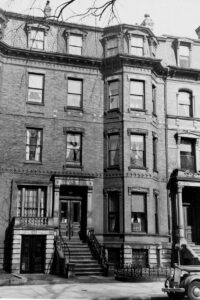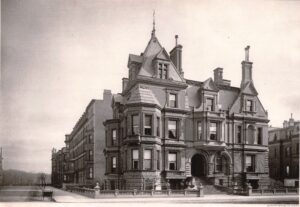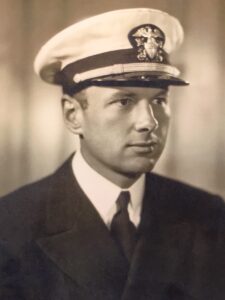 127 Commonwealth Avenue in Boston. (The Ayer family also owned 125, at right.) Photo by Bainbridge Bunting. Courtesy of Back Bay Houses/The Gleason Partnership
127 Commonwealth Avenue in Boston. (The Ayer family also owned 125, at right.) Photo by Bainbridge Bunting. Courtesy of Back Bay Houses/The Gleason Partnership
My grandmother[1] and her sister[2] grew up in the country, and both considered themselves countrywomen, devoted to family and animals, later managing farms on the North Shore of Boston, on Long Island, and in Virginia. (My great-aunt, who left New England for Virginia, had much the most significant spread, on land near Middleburg, acquired years before the development of Dulles Airport made the neighborhood a commuting town for Washington, D.C.)
They also grew up in the city. While both were born in their parents’ summer homes in the country, Theo and Anne Ayer were brought up at 161 Bay State Road, 127 Commonwealth Avenue, and, finally, 315 Dartmouth Street in Boston, from which house Aunt Theo was married in 1928. My grandmother married a New Yorker, with some Boston connections, but Aunt Theo married, one could say, “the boy next door.”
Her first husband, Bob Winthrop, was a neighbor both in Boston and in Hamilton.[3] Like the Ayers, the Winthrops enjoyed outdoor sports; life in the country, a hundred years ago, was considered preferable for people of all ages, but especially for children. When it came time for school, Theo and Anne were sent to Miss Winsor’s, in Boston, before Charlotte Noland’s Foxcroft School in Middleburg; Uncle Bob went to St. Mark’s School in Southborough, west of Boston, before Harvard College.
Boston (and, sometimes, New York) was where amusing parties were held, many in large private houses on tree-shaded avenues. The Ayers moved to Commonwealth Avenue about the time my grandmother was born, and to Dartmouth Street in 1922; Bob’s family lived first on Beacon Street, then in a (since-demolished) house on Berkeley Street.
 299 Berkeley Street, from the 31 March 1888 American Architect and Building News. Courtesy of Back Bay Houses
299 Berkeley Street, from the 31 March 1888 American Architect and Building News. Courtesy of Back Bay Houses
The Winthrops’ Berkeley Street house had quite a story. The land under 299 Berkeley Street was put together in a series of transactions over the span of a decade, and when a house finally went up it was impressive. It was also short-lived, as the fortune of Josiah Caldwell – made in textiles, mining, and railroads – evaporated while his new house was under construction. The Caldwell place was designed (by Arthur Delavan Gilman, architect of 1-3 Arlington Street and 20-36 Commonwealth Avenue, among other commissions) as a showplace.[4]
It took several years for the empty Caldwell shell to be offered for sale, and when it was it went to a developer (who paid the back taxes) and then was sold to Benjamin E. Bates, who promptly split the (large) lot in two and sold half to John C. Phillips. The Caldwell house was taken down, and John and Anna (Tucker) Phillips hired Peabody & Stearns to build their new house.[5] (They also had the right to the Caldwell house materials on the portion of the old lot held by Mr. Bates.)
When it was completed the Phillips house was considered “the finest house in Boston”...
When it was completed the Phillips house was considered “the finest house in Boston,” according to the Boston Daily Advertiser.[6] Mrs. Phillips long outlived her husband, sharing 299 Berkeley during the last year of her life with Governor and Mrs. Eben Sumner Draper while their nearby house was renovated following a fire. The Phillips estate sold the house to (the not-closely-related) James Sumner Draper, a real estate investor, who in turn sold it to Mr. and Mrs. Frederic Winthrop.
Frederic Winthrop of New York had married Dorothy Amory in 1903, buying the unfinished Robert Gould Shaw place in Ipswich and completing it while they became the parents of three children. Dorothy Amory Winthrop died in a riding accident at Groton House in 1907, and in 1911 Frederic married Sarah Barroll Thayer; they bought the Berkeley Street house two months later.
It was here that Bob, Dorothy, and Fred Winthrop grew up, joined by their half-siblings Nat, John (who died young), and Kay. Theo Ayer was just around the corner on Commonwealth Avenue and, later, on Dartmouth Street. In the country their houses were a horse ride or motor drive away; in the city, Bob and Theo could see each other by walking down the street.
Notes
[1] Anne Beekman Ayer (1908-1947) married Gilbert Livingston Steward in 1927.
[2] Theodora Ayer (1905-1996) was married to Robert Winthrop 1928-42 and to Dr. Archibald Cary Randolph 1942-60.
[3] The Ayers’ house, “Juniper Ridge,” was in South Hamilton; the Winthrops’ “Groton House” straddles Hamilton and Ipswich, and is sometimes placed in one town, sometimes in the other.
[4] The editor of the Back Bay Houses blog notes that Caldwell’s business failure had an indirect effect on the 1876 presidential election, in that it revealed Congressman James G. Blaine in some unsavory business maneuvers.
[5] Peabody & Stearns were the architects of 306 Dartmouth Street, built for Mr. and Mrs. Stephen Van Rensselaer Thayer, across the street from the house in which my great-aunt and grandmother were living during the 1920s.
[6] 28 November 1879.
Share this:
About Scott C. Steward
Scott C. Steward has been NEHGS’ Editor-in-Chief since 2013. He is the author, co-author, or editor of genealogies of the Ayer, Le Roy, Lowell, Saltonstall, Thorndike, and Winthrop families. His articles have appeared in The New England Historical and Genealogical Register, NEXUS, New England Ancestors, American Ancestors, and The Pennsylvania Genealogical Magazine, and he has written book reviews for the Register, The New York Genealogical and Biographical Record, and the National Genealogical Society Quarterly.View all posts by Scott C. Steward →
